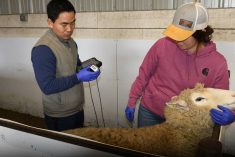Imagine trying to provide a full-body buzz cut to a woolly, four-legged Greco-Roman wrestling opponent.
That’s sheep shearing in a nutshell.
Nine students had a chance to hone their technique at a recent two-day sheep-shearing school sponsored by the Canadian Co-operative Wool Growers and hosted by Miniota shepherd Brian Greaves.
Shearing is a lot like dancing, said Greaves, who was taught by his grandfather back in New Zealand.
“Footwork is very important, but you have to be able to multi-task,” said Greaves, also a director of the wool growers’ co-op.
Read Also

Pig transport stress costs pork sector
Popular livestock trailer designs also increase pig stress during transportation, hitting at meat quality, animal welfare and farm profit, Agriculture and Agri-Food Canada researcher says
“You have to concentrate on where your feet are, how you’re holding the sheep, and your blows.”
With an ample supply of cull ewes on hand in Tony Atkinson’s spacious shed, the students were quickly put through their paces by Greaves and two young professional shearers. A few rams and lambs were thrown into the mix, and after the first day, some 60 shorn sheep scampered into the holding pens.
As the wool piled up, the students were shown how to clean it on a table and pack it into square bags using a wool press.
Speed was the focus for Darlingford-area shepherd Jonathon Nichol, who runs 35 ewes on 80 acres.
“I’m looking to get faster for my own flock, and to possibly be able to do some custom shearing at a speed that is economical and makes me a bit of money,” he said.
Before the course, his best day was a “very tiring” 50 head, but he upped speed substantially at the school with “less blows, less movements, and fighting less.”
South African-born shepherd Wian Prinsloo said he is hoping that learning how to shear will move him a step closer to his lifelong dream of farming full time.
Currently running about 100 ewes on a rented quarter section near Nesbitt, the crop insurance adjuster and his partner Lydia Carpenter are interested in learning all they can about all aspects of farming. They still plan to hire a shearer next year, however, because it’s hard to justify the $2,000 cost of brand new, top-of-the-line clippers.
“In the next year or two, depending on how the flock grows, we’ll likely invest in a machine,” said Carpenter.
Carberry-area shepherd Jeff Bieganski, who runs about 80 purebred Dorset ewes, was hoping to improve his shearing skills so that he could shear a few when necessary and prepare his own animals prior to shows.
“I just want learn so that I can do a few when the shearer can’t show up,” he said, adding that getting small numbers of sheep done outside the shearing season can be costly.
Practice is key
However, students were warned that practice is key, with one of the professional shearers quipping that “the first 10,000 are the hardest.”
Russell Eddy — although just 16 — knows all about that after learning the craft from his father Chris on the family farm near Yorkton, Sask.
He can now shear 80 to 90 sheep in a day and has a personal best of 102. But those numbers seemed impossible when he started out.
“Trying to get above 30 was extremely painful,” he said. “The first day I got to 40, I thought I was going to die. When I got to 65, that was probably the most painful day of my life. But this year, I’ve steadily increased because once you get through the beginning, it becomes way easier.”
Once the “fighting” with the sheep is minimized, a shearer can look for ways to drop a stroke, and generally increase speed, he said.
The “blows” or strokes with the clippers, follow a carefully thought-out pattern that follows the contours of the animal’s body with the aim of being both speedy and producing the best possible fleece.
Greaves taught an updated version of the Bowen technique, first developed in the 1950s by New Zealand shearer Godfrey Bowen, who was the first to shear a sheep in less than a minute.
Greaves, who in his prime sheared over 300 head in a day, said a controversy that erupted within the Manitoba shepherding community over a perceived shortage of shearers has led to increased interest on the part of students, noting this year’s course was filled up well in advance.
A two-day course isn’t enough to mint expert shearers, but can help shepherds with small flocks get a good handle on the basics, he said.



















